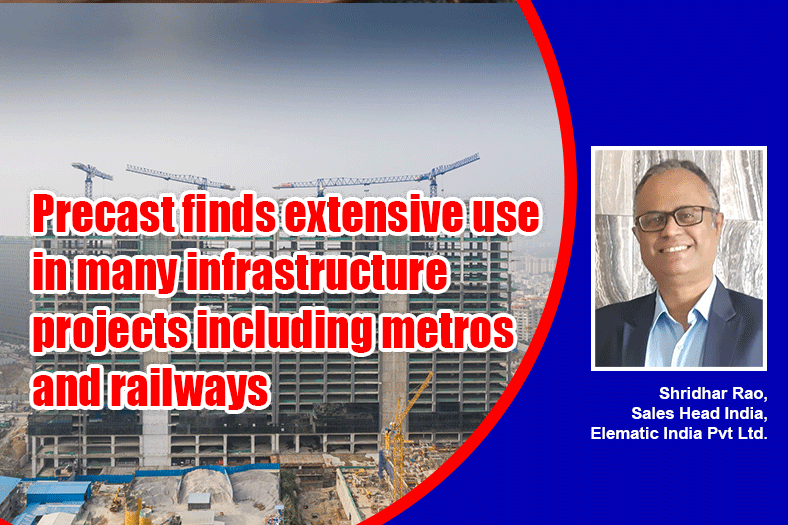Precast finds extensive use in many infrastructure projects including metros and railways

Precast is also used extensively for constructing sleepers and bridges. Mass housing projects, large commercial buildings, car parks, malls and hospitals have also been constructed using the same technology, says Shridhar Rao, Sales Head India, Elematic India Pvt Ltd.
What kind of control does precast concrete offer on the job site and schedule?
Precast technology enables off-site manufacturing of structural elements of a building, which is then transported to the site and constructed as a building. This allows speedy execution of projects where we design, manufacture and construct the building as parallel activities.
This provides the following benefits.
• Reduction in the timeline for construction of structure by 50 per cent
• Reduction of labour at the site by 60 per cent due to mechanization of planned activity
• Optimised building design using the virtual model and BIM
Aurobindo Realty at Hyderabad is a 28 storey commercial building. They achieved a one-floor cycle in 7-10 days with precast concrete in comparison to Cast-in- situ construction, which takes 15-21 days.
Having said that, what kind of role does it play in large scale infrastructure projects like huge buildings, bridges, metros and railways etc?
Precast is used extensively in many infrastructure projects such as metros, railway sleepers, bridges etc. Mass housing projects, large commercial buildings, car parks, malls and hospitals have also been constructed using the same technology. Large scale projects are almost impossible to build using Cast in situ construction methods using a large labour force. Technology intervention streamlines the construction process and offers the efficiency and speed to match timelines along with the quality of construction.
What can be said about the strength and resilience offered by precast concrete over a longer time? What kind of maintenance is desired?
Precast being a factory-made product, it is inherently by the process demand. Precast is a high quality and durable product that can have an expected life of more than 100 years. There are already buildings that are more than 50 years old and still going strong. Precast buildings do not require plaster and mortar for infill walls and as such do not leak or have seepage problems when designed properly. The joint material and sealant have a life of 10-15 years and when applied properly; gives you a long life that brings down the maintenance of the building.
What are the specific products in your portfolio dedicated for such large scale infrastructure projects?
A large scale building infrastructure project shall have the following precast elements for which Elematic provides precast plant and machinery.
• Prestressed hollow core slabs
• Prestressed beams and non-prestressed beams
• Precast column with corbel
• Precast walls and shear walls
• Precast staircase
26
Cookie Consent
We use cookies to personalize your experience. By continuing to visit this website you agree to our Terms & Conditions, Privacy Policy and Cookie Policy.









